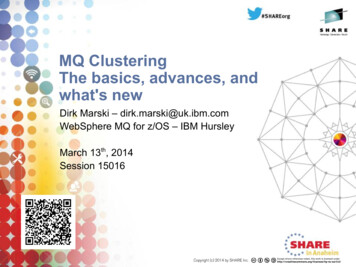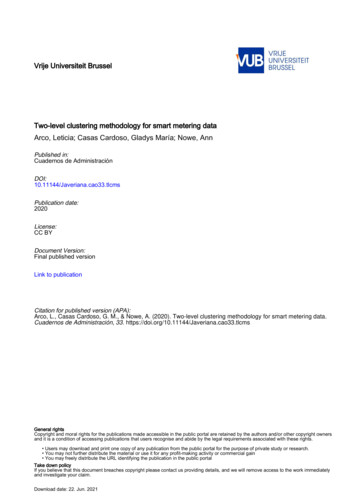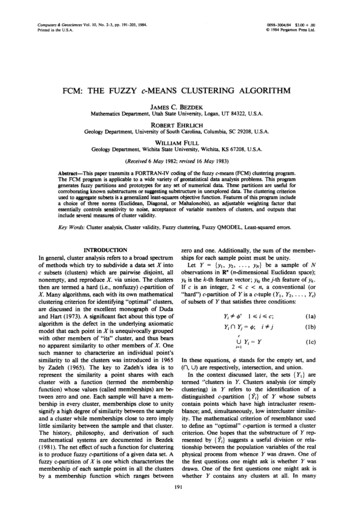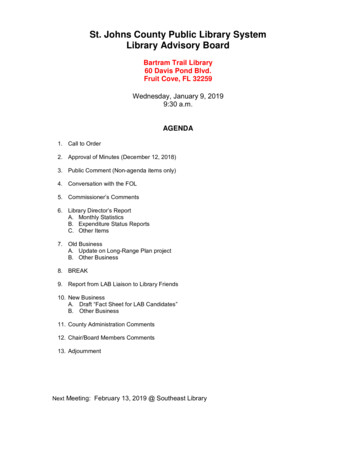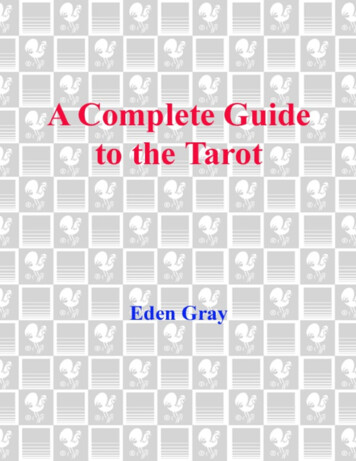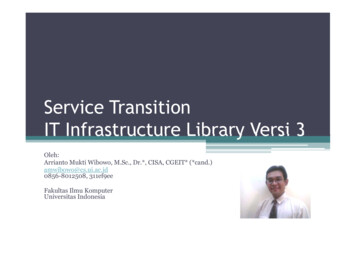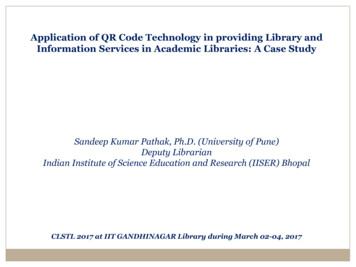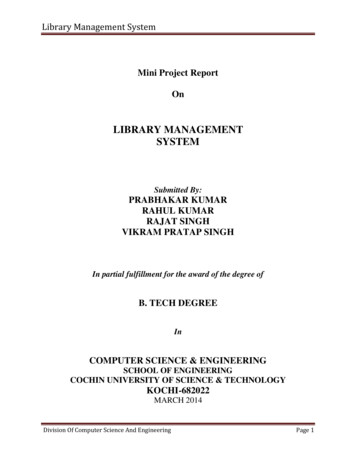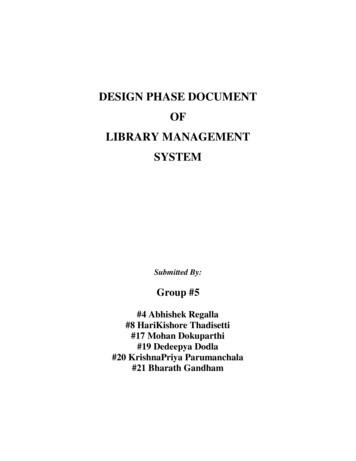
Transcription
The C Clustering LibraryThe University of Tokyo, Institute of Medical Science, Human Genome CenterMichiel de Hoon, Seiya Imoto, Satoru Miyano
30 August 2019The C Clustering Library for cDNA microarray data.Copyright c 2002-2005 Michiel Jan Laurens de HoonThis library was written at the Laboratory of DNA Information Analysis, Human GenomeCenter, Institute of Medical Science, University of Tokyo, 4-6-1 Shirokanedai, Minato-ku,Tokyo 108-8639, Japan.Contact: michiel.dehoon "AT" riken.jpPermission to use, copy, modify, and distribute this software and its documentation with orwithout modifications and for any purpose and without fee is hereby granted, provided thatany copyright notices appear in all copies and that both those copyright notices and thispermission notice appear in supporting documentation, and that the names of the contributors or copyright holders not be used in advertising or publicity pertaining to distributionof the software without specific prior permission.THE CONTRIBUTORS AND COPYRIGHT HOLDERS OF THIS SOFTWARE DISCLAIM ALL WARRANTIES WITH REGARD TO THIS SOFTWARE, INCLUDING ALLIMPLIED WARRANTIES OF MERCHANTABILITY AND FITNESS, IN NO EVENTSHALL THE CONTRIBUTORS OR COPYRIGHT HOLDERS BE LIABLE FOR ANYSPECIAL, INDIRECT OR CONSEQUENTIAL DAMAGES OR ANY DAMAGES WHATSOEVER RESULTING FROM LOSS OF USE, DATA OR PROFITS, WHETHER IN ANACTION OF CONTRACT, NEGLIGENCE OR OTHER TORTIOUS ACTION, ARISING OUT OF OR IN CONNECTION WITH THE USE OR PERFORMANCE OF THISSOFTWARE.
iTable of Contents1Introduction . . . . . . . . . . . . . . . . . . . . . . . . . . . . . . . . . . . . . 12Distance functions . . . . . . . . . . . . . . . . . . . . . . . . . . . . . . . 22.12.22.32.42.52.62.72.82.92.102.112.122.133Data handling . . . . . . . . . . . . . . . . . . . . . . . . . . . . . . . . . . . . . . . . . . . . . . . . . . 3Weighting . . . . . . . . . . . . . . . . . . . . . . . . . . . . . . . . . . . . . . . . . . . . . . . . . . . . . . 3Missing Values . . . . . . . . . . . . . . . . . . . . . . . . . . . . . . . . . . . . . . . . . . . . . . . . . 3The Pearson correlation coefficient . . . . . . . . . . . . . . . . . . . . . . . . . . . . . . 3Absolute Pearson correlation . . . . . . . . . . . . . . . . . . . . . . . . . . . . . . . . . . . . 4Uncentered correlation (cosine of the angle) . . . . . . . . . . . . . . . . . . . . . 4Absolute uncentered correlation . . . . . . . . . . . . . . . . . . . . . . . . . . . . . . . . . 5Spearman rank correlation . . . . . . . . . . . . . . . . . . . . . . . . . . . . . . . . . . . . . . 5Kendall’s rank correlation . . . . . . . . . . . . . . . . . . . . . . . . . . . . . . . . . . . . . . 5Euclidean distance. . . . . . . . . . . . . . . . . . . . . . . . . . . . . . . . . . . . . . . . . . . . . 5City-block distance . . . . . . . . . . . . . . . . . . . . . . . . . . . . . . . . . . . . . . . . . . . . 6Calculating the distance between clusters . . . . . . . . . . . . . . . . . . . . . . 6The distance matrix . . . . . . . . . . . . . . . . . . . . . . . . . . . . . . . . . . . . . . . . . . . 8Partitioning algorithms . . . . . . . . . . . . . . . . . . . . . . . . 103.1 Initialization . . . . . . . . . . . . . . . . . . . . . . . . . . . . . . . . . . . . . . . . . . . . . . . . . . 103.2 Finding the cluster centroid. . . . . . . . . . . . . . . . . . . . . . . . . . . . . . . . . . . . 113.2.1 Finding the cluster mean or median . . . . . . . . . . . . . . . . . . . . . . . 113.2.2 Finding the cluster medoid. . . . . . . . . . . . . . . . . . . . . . . . . . . . . . . . 123.3 The EM algorithm . . . . . . . . . . . . . . . . . . . . . . . . . . . . . . . . . . . . . . . . . . . . 133.4 Finding the optimal solution . . . . . . . . . . . . . . . . . . . . . . . . . . . . . . . . . . . 133.4.1 k -means and k -medians . . . . . . . . . . . . . . . . . . . . . . . . . . . . . . . . . . . 133.4.2 k -medoids . . . . . . . . . . . . . . . . . . . . . . . . . . . . . . . . . . . . . . . . . . . . . . . . 153.5 Choosing the distance measure . . . . . . . . . . . . . . . . . . . . . . . . . . . . . . . . 164Hierarchical clustering . . . . . . . . . . . . . . . . . . . . . . . . . 174.14.24.34.4Representing a hierarchical clustering solution . . . . . . . . . . . . . . . . . 18Performing hierarchical clustering: treecluster . . . . . . . . . . . . . . . 18Sorting a hierarchical clustering tree: sorttree . . . . . . . . . . . . . . . . 20Cutting a hierarchical clustering tree: cuttree . . . . . . . . . . . . . . . . . 215Self-Organizing Maps . . . . . . . . . . . . . . . . . . . . . . . . . . 226Principal Component Analysis . . . . . . . . . . . . . . . . 257The random number generator . . . . . . . . . . . . . . . 27
ii8Using the C Clustering Library with Python:Pycluster and Bio.Cluster . . . . . . . . . . . . . . . . . . . . . . 288.1 Partitioning algorithms . . . . . . . . . . . . . . . . . . . . . . . . . . . . . . . . . . . . . . . . 288.1.1 k -means and k -medians clustering: kcluster . . . . . . . . . . . . . 288.1.2 k -medoids clustering: kmedoids . . . . . . . . . . . . . . . . . . . . . . . . . . . 298.2 Hierarchical clustering . . . . . . . . . . . . . . . . . . . . . . . . . . . . . . . . . . . . . . . . . 318.2.1 Representing a hierarchical clustering solution . . . . . . . . . . . . . 318.2.2 Performing hierarchical clustering: treecluster . . . . . . . . . . 328.2.3 Scaling a hierarchical clustering tree: tree.scale . . . . . . . . . 348.2.4 Sorting a hierarchical clustering tree: tree.sort . . . . . . . . . . 348.2.5 Cutting a hierarchical clustering tree: tree.cut . . . . . . . . . . . 358.3 Self-Organizing Maps: somcluster . . . . . . . . . . . . . . . . . . . . . . . . . . . . 358.4 Finding the cluster centroids: clustercentroids . . . . . . . . . . . . . . 368.5 The distance between two clusters: clusterdistance . . . . . . . . . . 378.6 Calculating the distance matrix: distancematrix . . . . . . . . . . . . . . 388.7 Principal Component Analysis: pca . . . . . . . . . . . . . . . . . . . . . . . . . . . . 398.8 Handling Cluster/TreeView-type files . . . . . . . . . . . . . . . . . . . . . . . . . . 408.8.1 The Record class . . . . . . . . . . . . . . . . . . . . . . . . . . . . . . . . . . . . . . . . . 408.8.2 Performing hierarchical clustering . . . . . . . . . . . . . . . . . . . . . . . . . 418.8.3 Performing k -means or k -medians clustering . . . . . . . . . . . . . . 428.8.4 Calculating a Self-Organizing Map . . . . . . . . . . . . . . . . . . . . . . . . 438.8.5 Finding the cluster centroid . . . . . . . . . . . . . . . . . . . . . . . . . . . . . . . 448.8.6 Calculating the distance between two clusters . . . . . . . . . . . . . 458.8.7 Calculating the distance matrix . . . . . . . . . . . . . . . . . . . . . . . . . . . 468.8.8 Saving the clustering result . . . . . . . . . . . . . . . . . . . . . . . . . . . . . . . 478.8.9 Example calculation . . . . . . . . . . . . . . . . . . . . . . . . . . . . . . . . . . . . . . 479Using the C Clustering Library with Perl:Algorithm::Cluster . . . . . . . . . . . . . . . . . . . . . . . . . . . . . . 499.1 Using named parameters . . . . . . . . . . . . . . . . . . . . . . . . . . . . . . . . . . . . . . 499.2 References to arrays, and two-dimensional matrices . . . . . . . . . . . . 509.3 Partitioning algorithms . . . . . . . . . . . . . . . . . . . . . . . . . . . . . . . . . . . . . . . . 519.3.1 The k -means clustering algorithm: kcluster . . . . . . . . . . . . . . 519.3.2 The k -medoids algorithm: kmedoids . . . . . . . . . . . . . . . . . . . . . . 539.4 Hierarchical clustering: treecluster . . . . . . . . . . . . . . . . . . . . . . . . . . 549.4.1 Representing a hierarchical clustering solution . . . . . . . . . . . . . 549.4.2 Performing hierarchical clustering: treecluster . . . . . . . . . . 569.4.3 Scaling a hierarchical clustering tree: tree- scale . . . . . . . 589.4.4 Sorting a hierarchical clustering tree: tree- sort . . . . . . . . 589.4.5 Cutting a hierarchical clustering tree: tree- cut . . . . . . . . 589.5 Self-Organizing Maps: somcluster . . . . . . . . . . . . . . . . . . . . . . . . . . . . 599.6 Finding the cluster centroids: clustercentroids . . . . . . . . . . . . . . 619.7 The distance between two clusters: clusterdistance . . . . . . . . . . 629.8 Calculating the distance matrix: distancematrix . . . . . . . . . . . . . . 639.9 Principal Component Analysis: pca . . . . . . . . . . . . . . . . . . . . . . . . . . . . 649.10 Auxiliary functions . . . . . . . . . . . . . . . . . . . . . . . . . . . . . . . . . . . . . . . . . . . 659.11 Handling Cluster/TreeView-type files . . . . . . . . . . . . . . . . . . . . . . . . . 65
89.11.910The Record class . . . . . . . . . . . . . . . . . . . . . . . . . . . . . . . . . . . . . . . . 65Performing hierarchical clustering . . . . . . . . . . . . . . . . . . . . . . . . 66Performing k -means or k -medians clustering . . . . . . . . . . . . . 67Calculating a Self-Organizing Map . . . . . . . . . . . . . . . . . . . . . . . 68Finding the cluster centroid. . . . . . . . . . . . . . . . . . . . . . . . . . . . . . 69Calculating the distance between two clusters . . . . . . . . . . . . 70Calculating the distance matrix . . . . . . . . . . . . . . . . . . . . . . . . . . 71Saving the clustering result . . . . . . . . . . . . . . . . . . . . . . . . . . . . . . 72Example calculation . . . . . . . . . . . . . . . . . . . . . . . . . . . . . . . . . . . . . 72Compiling and linking . . . . . . . . . . . . . . . . . . . . . . . . 7410.110.210.310.410.510.610.7Installing the C Clustering Library for Python . . . . . . . . . . . . . . . . 74Installing the C Clustering Library for Perl . . . . . . . . . . . . . . . . . . . 74Accessing the C Clustering Library from C/C . . . . . . . . . . . . . 75Installing Cluster 3.0 for Windows . . . . . . . . . . . . . . . . . . . . . . . . . . . . 75Installing Cluster 3.0 for Mac OS X. . . . . . . . . . . . . . . . . . . . . . . . . . . 76Installing Cluster 3.0 for Linux/Unix . . . . . . . . . . . . . . . . . . . . . . . . . 76Installing Cluster 3.0 as a command line program . . . . . . . . . . . . . 76Bibliography . . . . . . . . . . . . . . . . . . . . . . . . . . . . . . . . . . . . . . . . 78
11 IntroductionClustering is widely used in gene expression data analysis. By grouping genes togetherbased on the similarity between their gene expression profiles, functionally related genesmay be found. Such a grouping suggests the function of presently unknown genes.The C Clustering Library is a collection of numerical routines that implement the clustering algorithms that are most commonly used. The routines can be applied both to genesand to arrays. The clustering algorithms are: Hierarchical clustering (pairwise centroid-, single-, complete-, and average-linkage); k -means clustering; Self-Organizing Maps; Principal Component Analysis.To measure the similarity or distance between gene expression data, eight distance measures are available: Pearson correlation; Absolute value of the Pearson correlation; Uncentered Pearson correlation (equivalent to the cosine of the angle between two datavectors); Absolute uncentered Pearson correlation (equivalent to the cosine of the smallest anglebetween two data vectors); Spearman’s rank correlation; Kendall’s rank correlation τ ; Euclidean distance; City-block distance.This library was written in ANSI C and can therefore be easily linked to other C/C programs. Cluster 3.0 (http: / / bonsai . hgc . jp / mdehoon / software / cluster) is anexample of such a program. This library may be particularly useful when called from ascripting language such as Python (http://www.python.org), Perl (http://www.perl.org), or Ruby (http://www.ruby.org). The C Clustering Library contains wrappers forPython and Perl; interfaces to other scripting languages may be generated using SWIG(http://www.swig.org).This manual contains a description of clustering techniques, their implementation in theC Clustering Library, the Python and Perl modules that give access to the C ClusteringLibrary, and information on how to use the routines in the library from other C or C programs.The C Clustering Library was released under the Python License.Michiel de Hoon (michiel.dehoon "AT" riken.jp; mdehoon "AT" cal.berkeley.edu),Seiya Imoto, Satoru MiyanoLaboratory of DNA Information Analysis, Human Genome Center, Institute of MedicalScience, University of Tokyo.
22 Distance functionsIn order to cluster gene expression data into groups with similar genes or microarrays, weshould first define what exactly we mean by similar. In the C Clustering Library, eightdistance functions are available to measure similarity, or conversely, distance:‘c’Pearson correlation coefficient;‘a’Absolute value of the Pearson correlation coefficient;‘u’Uncentered Pearson correlation (equivalent to the cosine of the angle betweentwo data vectors);‘x’Absolute uncentered Pearson correlation;‘s’Spearman’s rank correlation;‘k’Kendall’s rank correlation τ ;‘e’Euclidean distance;‘b’City-block distance.The first six of these distance measures are related to the correlation coefficient, whilethe remaining three are related to the Euclidean distance. The characters in front of thedistance measures are used as mnemonics to be passed to various routines in the C ClusteringLibrary.One of the properties one would like to see in a distance function is that it satisfies thetriangle inequality:d (u, v) d (u, w) d (w, v) for all u, v, w.In everyday language, this equation means that the shortest distance between two points isa straight line.Correlation-based distance functions usually define the distance d in terms of the correlation r asd 1 r.All correlation-based similarity measures are converted to a distance using this definition.Note that this distance function does not satisfy the triangle inequality. As an example, tryu (1, 0, 1) ;v (1, 1, 0) .w (0, 1, 1) ;Using the Pearson correlation, we find d (u, w) 1.8660, while d (u, v) d (v, w) 1.6340.None of the distance functions based on the correlation coefficient satisfy the triangle inequality; this is a general characteristic of the correlation coefficient. The Euclidean distance and the city-block distance, which are metrics, do satisfy the triangle inequality. Thecorrelation-based distance functions are sometimes called semi-metric.
Chapter 2: Distance functions32.1 Data handlingThe input to the distance functions contains two arrays and two row or column indices,instead of two data vectors. This makes it easier to calculate the distance between twocolumns in the gene expression data matrix. If the distance functions would require twovectors, we would have to extract two columns from the matrix and save them in twovectors to be passed to the distance function. In order to specify if the distance betweenrows or between columns is to be calculated, each distance function has a flag transpose. Iftranspose 0, then the distance between two rows is calculated. Otherwise, the distancebetween two columns is calculated.2.2 WeightingFor most of the distance functions available in the C Clustering Library, a weight vectorcan be applied. The weight vector contains weights for the elements in the data vector. Ifthe weight for element i is wi , then that element is treated as if it occurred wi times in thedata. The weight do not have to be integers.2.3 Missing ValuesOften in microarray experiments, some of the data values are missing. In the distancefunctions, we therefore use an additional matrix mask which shows which data values aremissing. If mask[i][j] 0, then data[i][j] is missing, and is not included in the distancecalculation.2.4 The Pearson correlation coefficientThe Pearson correlation coefficient is defined asn1Xxi x̄r n i 1σx yi ȳσy in which x̄, ȳ are the sample mean of x and y respectively, and σx , σy are the sample standarddeviation of x and y. The Pearson correlation coefficient is a measure for how well a straightline can be fitted to a scatterplot of x and y. If all the points in the scatterplot lie on astraight line, the Pearson correlation coefficient is either 1 or 1, depending on whetherthe slope of line is positive or negative. If the Pearson correlation coefficient is equal tozero, there is no correlation between x and y.The Pearson distance is then defined asdP 1 r.As the Pearson correlation coefficient lies between 1 and 1, the Pearson distance liesbetween 0 and 2.Note that the Pearson correlation automatically centers the data by subtracting themean, and normalizes them by dividing by the standard deviation. While such normalization may be useful in some situations (e.g., when clustering gene expression levels directlyinstead of gene expression ratios), information is being lost in this step. In particular, themagnitude of changes in gene expression is being ignored. This is in fact the reason thatthe Pearson distance does not satisfy the triangle inequality.
Chapter 2: Distance functions42.5 Absolute Pearson correlationBy taking the absolute value of the Pearson correlation, we find a number between zeroand one. If the absolute value is one, all the points in the scatter plot lie on a straight linewith either a positive or a negative slope. If the absolute value is equal to zero, there is nocorrelation between x and y.The distance is defined as usual asdA 1 r ,where r is the Pearson correlation coefficient. As the absolute value of the Pearson correlation coefficient lies between 0 and 1, the corresponding distance lies between 0 and 1 aswell.In the context of gene expression experiments, note that the absolute correlation isequal to one if the gene expression data of two genes/microarrays have a shape that iseither exactly the same or exactly opposite. The absolute correlation coefficient shouldtherefore be used with care.2.6 Uncentered correlation (cosine of the angle)In some cases, it may be preferable to use the uncentered correlation instead of the regularPearson correlation coefficient. The uncentered correlation is defined asn1XxirU n i 1 σx(0) whereσx(0)σy(0) yi(0)σy!,vunu1 X tx2i ;ni 1vunu1 Xyi2 . tni 1This is the same expression as for the regular Pearson correlation coefficient, except thatthe sample means x̄, ȳ are set equal to zero. The uncentered correlation may be appropriateif there is a zero reference state. For instance, in the case of gene expression data given interms of log-ratios, a log-ratio equal to zero corresponds to the green and red signal beingequal, which means that the experimental manipulation did not affect the gene expression.The distance corresponding to the uncentered correlation coefficient is defined asd U 1 rU ,where rU is the uncentered correlation. As the uncentered correlation coefficient lies between 1 and 1, the corresponding distance lies between 0 and 2.The uncentered correlation is equal to the cosine of the angle of the two data vectors inn-dimensional space, and is often referred to as such. (From this viewpoint, it would makemore sense to define the distance as the arc cosine of the uncentered correlation coefficient).
Chapter 2: Distance functions52.7 Absolute uncentered correlationAs for the regular Pearson correlation, we can define a distance measure using the absolutevalue of the uncentered correlation:dAU 1 rU ,where rU is the uncentered correlation coefficient. As the absolute value of the uncenteredcorrelation coefficient lies between 0 and 1, the corresponding distance lies between 0 and1 as well.Geometrically, the absolute value of the uncentered correlation is equal to the cosinebetween the supporting lines of the two data vectors (i.e., the angle without taking thedirection of the vectors into consideration).2.8 Spearman rank correlationThe Spearman rank correlation is an example of
Center, Institute of Medical Science, University of Tokyo, 4-6-1 Shirokanedai, Minato-ku, Tokyo 108-8639, Japan. Contact: michiel.dehoon"AT"riken.jp Permission to use, copy, modify, and distribute this software and its documentation with or without modifications and for any
